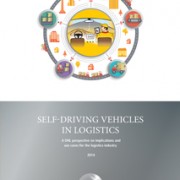Autonomous Vehicles — Much More Efficient, Just as Many Sold
Burney Simpson
Automakers can breathe a sigh of relief.
According to a new study, a U.S. filled with fully-autonomous driverless vehicles could see a huge drop in the number of vehicles per household but there will be no corresponding decline in the total number of vehicles sold.
“While each household would potentially own fewer vehicles, they would put significantly more miles on the vehicle(s) that they do own. So households might trade owning fewer vehicles for needing to replace them much more often,” Brandon Schoettle, co-author with Michael Sivak of “Potential Impact of Self-Driving Vehicles on Household Vehicle Demand and Usage,” writes to Driverless Transportation in an email.
These driverless vehicles are defined as Full Self-Driving Automation (Level 4) by the National Highway Traffic Safety Administration (NHTSA). The agency says a Level 4 vehicle “perform(s) all safety-critical driving functions and monitor(s) roadway conditions for an entire trip.” The agency categorizes vehicles as Level 0 to Level 4 depending on their autonomous capabilities, with 4 as the highest.
Once Level 4 vehicles are widely available the average number of vehicles-per-household would drop 43 percent, from today’s 2.1 to 1.2, according to Schoettle and Sivak, researchers with the Transportation Research Institute at the University of Michigan.
That’s because many households would purchase a single Level 4 vehicle to replace multiple cars without driverless capability, treating their high-tech cars as ‘return-to-home’ vehicles.
Theoretically, these households only use a vehicle when necessary and it then drives itself home, instead of sitting parked for most of the day. For example, the driverless car drops off the commuter in a household at a public transit station around 8 a.m., and the vehicle returns home. Other household members use it twice during the day. Around 5 p.m., the vehicle drives itself back to the station to pick up the commuter for the return trip home.
The researcher’s analysis of the 2009 National Household Travel Survey from the U.S. Department of Transportation found that nearly 84 percent of household trips today do not overlap with other household trips. This suggests that only 16 percent of American households actually need to use two or more cars at the same time.
In this future-world where Level 4 cars are commonplace, households will run the vehicle for more hours-per-day and for more miles-per-year. This “would result in a 75 percent increase in individual vehicle usage” from 11,661 to 20,406 annual miles per vehicle, the report finds.
That would shorten vehicle lifespan from today’s average of more than 11 years to 6.5 years. That means households will need to replace their vehicle more often.
In addition, “(t)here is also the potential for non-drivers to become self-driving vehicle users, which would lead to more vehicles being purchased and/or more annual miles per vehicle,” notes Schoettle. “It could be the case that these forces combine to have only a minor impact on annual vehicle sales.”
The report suggests that further study is necessary, and acknowledges that many human factors are not taken into account in its conclusions. For instance, many consumers don’t want to share vehicles, and their commuter example assumes there is a place where people never miss trains that always run on time.
For the auto OEMs this report seems to offer pros and cons. On the one hand, consumers will demand tougher vehicles with more capabilities. On the other, that sounds like a good reason to raise prices.

